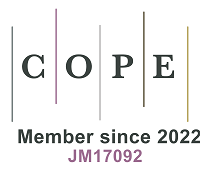REFERENCES
1. Aborode AT, Hasan MM, Jain S, et al. Impact of poor disease surveillance system on COVID-19 response in africa: time to rethink and rebuilt. Clin Epidemiol Glob Health 2021;12:100841.
2. Gonçalves J, Torres-Franco A, Rodriguéz E, et al. Centralized and decentralized wastewater-based epidemiology to infer COVID-19 transmission-a brief review. One Health 2022;15:100405.
3. Gonçalves J, Koritnik T, Mioč V, et al. Detection of SARS-CoV-2 RNA in hospital wastewater from a low COVID-19 disease prevalence area. Sci Total Environ 2021;755:143226.
4. Wolfe MK. Invited perspective: the promise of wastewater monitoring for infectious disease surveillance. Environ Health Perspect 2022;130:51302.
5. Paquet C, Coulombier D, Kaiser R, Ciotti M. Epidemic intelligence: a new framework for strengthening disease surveillance in Europe. Eurosurveillance 2006;11:5-6.
6. Scallan E. Activities, achievements, and lessons learned during the first 10 years of the foodborne diseases active surveillance network: 1996-2005. Clin Infect Dis 2007;44:718-25.
7. Ladner JT, Grubaugh ND, Pybus OG, Andersen KG. Precision epidemiology for infectious disease control. Nat Med 2019;25:206-11.
8. Chen C, Kostakis C, Gerber JP, Tscharke BJ, Irvine RJ, White JM. Towards finding a population biomarker for wastewater epidemiology studies. Sci Total Environ 2014;487:621-8.
9. Boogaerts T, Ahmed F, Choi PM, et al. Current and future perspectives for wastewater-based epidemiology as a monitoring tool for pharmaceutical use. Sci Total Environ 2021;789:148047.
10. González-Mariño I, Baz-Lomba JA, Alygizakis NA, et al. Spatio-temporal assessment of illicit drug use at large scale: evidence from 7 years of international wastewater monitoring. Addiction 2020;115:109-20.
11. Hernández F, Castiglioni S, Covaci A, et al. Mass spectrometric strategies for the investigation of biomarkers of illicit drug use in wastewater. Mass Spectrom Rev 2018;37:258-80.
12. Zuccato E, Chiabrando C, Castiglioni S, Bagnati R, Fanelli R. Estimating community drug abuse by wastewater analysis. Environ Health Perspect 2008;116:1027-32.
13. Adelodun B, Ajibade FO, Ibrahim RG, Bakare HO, Choi KS. Snowballing transmission of COVID-19 (SARS-CoV-2) through wastewater: any sustainable preventive measures to curtail the scourge in low-income countries? Sci Total Environ 2020;742:140680.
15. Acosta N, Bautista MA, Hollman J, et al. A multicenter study investigating SARS-CoV-2 in tertiary-care hospital wastewater. viral burden correlates with increasing hospitalized cases as well as hospital-associated transmissions and outbreaks. Water Res 2021;201:117369.
16. Ahmed W, Angel N, Edson J, et al. First confirmed detection of SARS-CoV-2 in untreated wastewater in Australia: a proof of concept for the wastewater surveillance of COVID-19 in the community. Sci Total Environ 2020;728:138764.
17. Bar-Or I, Weil M, Indenbaum V, et al. Detection of SARS-CoV-2 variants by genomic analysis of wastewater samples in Israel. Sci Total Environ 2021;789:148002.
18. Davó L, Seguí R, Botija P, et al. Early detection of SARS-CoV-2 infection cases or outbreaks at nursing homes by targeted wastewater tracking. Clin Microbiol Infect 2021;27:1061-3.
19. Huraimel K, Alhosani M, Kunhabdulla S, Stietiya MH. SARS-CoV-2 in the environment: modes of transmission, early detection and potential role of pollutions. Sci Total Environ 2020;744:140946.
20. Mota CR, Bressani-Ribeiro T, Araújo JC, et al. Assessing spatial distribution of COVID-19 prevalence in Brazil using decentralised sewage monitoring. Water Res 2021;202:117388.
21. Gracia-Lor E, Rousis NI, Hernández F, Zuccato E, Castiglioni S. Wastewater-based epidemiology as a novel biomonitoring tool to evaluate human exposure to pollutants. Environ Sci Technol 2018;52:10224-6.
22. Polo D, Quintela-Baluja M, Corbishley A, et al. Making waves: wastewater-based epidemiology for COVID-19-approaches and challenges for surveillance and prediction. Water Res 2020;186:116404.
23. Mao K, Zhang H, Pan Y, Yang Z. Biosensors for wastewater-based epidemiology for monitoring public health. Water Res 2021;191:116787.
24. Corpuz MVA, Buonerba A, Vigliotta G, et al. Viruses in wastewater: occurrence, abundance and detection methods. Sci Total Environ 2020;745:140910.
25. Pilevar M, Kim KT, Lee WH. Recent advances in biosensors for detecting viruses in water and wastewater. J Hazard Mater 2021;410:124656.
26. Baker RE, Mahmud AS, Miller IF, et al. Infectious disease in an era of global change. Nat Rev Microbiol 2022;20:193-205.
27. Chen Y, Liu J, Yang Z, Wilkinson JS, Zhou X. Optical biosensors based on refractometric sensing schemes: a review. Biosens Bioelectron 2019;144:111693.
28. Bao J, Hou C, Huo D, et al. Sensitive and selective electrochemical biosensor based on ELP-OPH/BSA/TiO2NFs/AuNPs for determination of organophosphate pesticides with p-Nitrophenyl substituent. J Electrochem Soc 2017;164:G17-22.
29. Mao K, Zhang H, Yang Z. Can a paper-based device trace COVID-19 sources with wastewater-based epidemiology? Environ Sci Technol 2020;54:3733-5.
30. Turner AP. Tech.sight. biochemistry. biosensors--sense and sensitivity. Science 2000;290:1315-7.
31. Biswas P, Karn AK, Balasubramanian P, Kale PG. Biosensor for detection of dissolved chromium in potable water: a review. Biosens Bioelectron 2017;94:589-604.
32. Mahmoudi T, Pourhassan-Moghaddam M, Shirdel B, Baradaran B, Morales-Narváez E, Golmohammadi H. (Nano)tag-antibody conjugates in rapid tests. J Mater Chem B 2021;9:5414-38.
33. Mahmoudi T, Naghdi T, Morales-Narváez E, Golmohammadi H. Toward smart diagnosis of pandemic infectious diseases using wastewater-based epidemiology. Trends Analyt Chem 2022;153:116635.
34. Cesewski E, Johnson BN. Electrochemical biosensors for pathogen detection. Biosens Bioelectron 2020;159:112214.
35. Gonçalves J, Díaz I, Torres-Franco A, et al. Microbial contamination of environmental waters and wastewater: detection methods and treatment technologies. Modern approaches in waste bioremediation: environmental microbiology. Springer International Publishing; 2023. pp. 461-83.
36. Javaid M, Khan IH. Internet of things (IoT) enabled healthcare helps to take the challenges of COVID-19 Pandemic. J Oral Biol Craniofac Res 2021;11:209-14.
37. Madrid RE, Ashur Ramallo F, Barraza DE, Chaile RE. Smartphone-based biosensor devices for healthcare: technologies, trends, and adoption by end-users. Bioengineering 2022;9:101.
38. Manickam P, Mariappan SA, Murugesan SM, et al. Artificial intelligence (AI) and internet of medical things (IoMT) assisted biomedical systems for intelligent healthcare. Biosensors 2022;12:562.
39. Sahu AK, Sharma S, Raja R. Deep learning-based continuous authentication for an iot-enabled healthcare service. Comput Electr Eng 2022;99:107817.
40. Vashist SK, Luong JHT. Smartphone-based point-of-care technologies for mobile healthcare. point-of-care technologies enabling next-generation healthcare monitoring and management. Cham: Springer International Publishing; 2019. pp. 27-79.
41. Xu X, Akay A, Wei H, et al. Advances in smartphone-based point-of-care diagnostics. Proc IEEE 2015;103:236-47.
42. Land KJ, Boeras DI, Chen XS, Ramsay AR, Peeling RW. REASSURED diagnostics to inform disease control strategies, strengthen health systems and improve patient outcomes. Nat Microbiol 2019;4:46-54.
43. Lin YL, Huang YJ, Teerapanich P, Leïchlé T, Chou CF. Multiplexed immunosensing and kinetics monitoring in nanofluidic devices with highly enhanced target capture efficiency. Biomicrofluidics 2016;10:034114.
44. Mortelmans T, Kazazis D, Padeste C, Berger P, Li X, Ekinci Y. A nanofluidic device for rapid and multiplexed SARS-CoV-2 serological antibody detection. Research Square 2021;1:online ahead of print.
45. Ye X, Li Y, Wang L, Fang X, Kong J. All-in-one microfluidic nucleic acid diagnosis system for multiplex detection of sexually transmitted pathogens directly from genitourinary secretions. Talanta 2021;221:121462.







